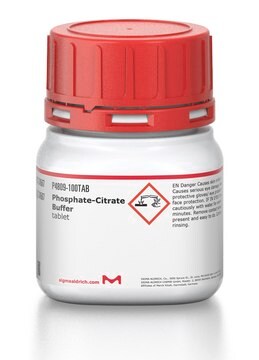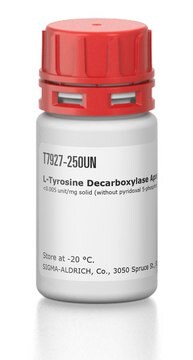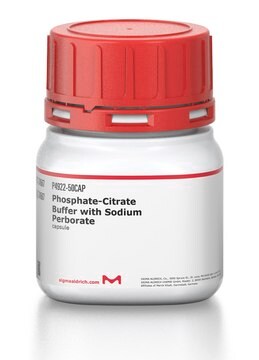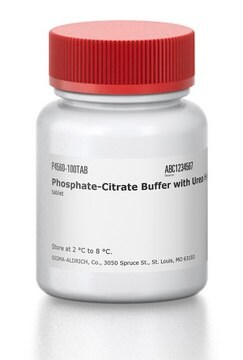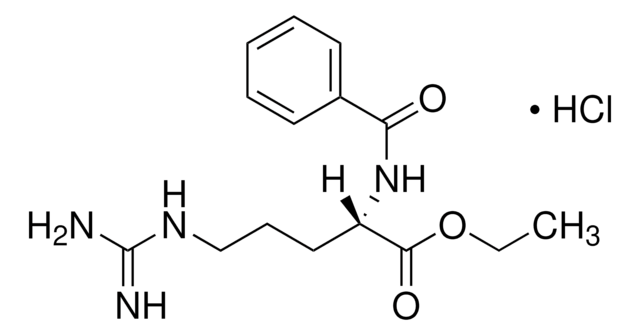T7677
L-Tyrosine Decarboxylase from Streptococcus faecalis
≥0.1 unit/mg solid
Sinónimos:
L-Tyrosine carboxy-lyase
Iniciar sesiónpara Ver la Fijación de precios por contrato y de la organización
About This Item
Productos recomendados
¿Está buscando productos similares? Visita Guía de comparación de productos
Application
L-Tyrosine decarboxylase from Streptococcus faecalis has been used in a study to isolate and identify the carbonyl-active site of diamine oxidase by gas chromatographic mass spectrometry. L-Tyrosine decarboxylase from Streptococcus faecalis has also been used in a study to investigate the adsorption of Streptococcus faecalis on diatomite carriers for use in biotransformations.
Other Notes
Dried cells from which activity can be extracted.
Unit Definition
One unit will cause the decomposition of 1.0 μmole of L-tyrosine per min at pH 6.2 at 37 °C.
Storage Class
11 - Combustible Solids
wgk_germany
WGK 3
flash_point_f
Not applicable
flash_point_c
Not applicable
ppe
Eyeshields, Gloves, type N95 (US)
Elija entre una de las versiones más recientes:
¿Ya tiene este producto?
Encuentre la documentación para los productos que ha comprado recientemente en la Biblioteca de documentos.
W A Anderson et al.
Journal of chemical technology and biotechnology (Oxford, Oxfordshire : 1986), 47(2), 93-100 (1990-01-01)
Adsorption of cells on particulate carriers is potentially one of the most cost-effective immobilization techniques available. Diatomite carriers, such as Celite, have desirable physical properties, are inexpensive, and are suitable for both mycelial and bacterial systems. This work investigated the
F Buffoni
Analytical biochemistry, 220(1), 185-191 (1994-07-01)
An adduct with phenylhydrazine was formed with the purified pig kidney diamine oxidase and in parallel with the l-tyrosine decarboxylase from Streptococcus faecalis. The labeled enzymes were hydrolyzed by chemical hydrolysis and the adducts released by hydrolysis were isolated and
Characterization of bacterial L-(-)-tyrosine decarboxylase by isoelectric focusing and gel chromatography
Allenmark, C. and B. Servenius
Journal of Chromatography A, 153, 238-245 (1978)
Daniel M Linares et al.
Microbial biotechnology, 2(6), 625-633 (2009-11-01)
The microbial decarboxylation of some amino acids leads to the undesirable presence of biogenic amines in foods. One of the most abundant and frequent biogenic amines found in fermented foods is tyramine, which is produced by the decarboxylation of tyrosine.
Nicole Tanz et al.
Journal of agricultural and food chemistry, 59(17), 9475-9483 (2011-07-12)
The δ(18)O value of the p-hydroxy group of L-tyrosine depends on the biosynthesis by plants or animals, respectively. In animal proteins it reflects the diet and is therefore an absolute indicator for illegal feeding with meat and bone meal. The
Nuestro equipo de científicos tiene experiencia en todas las áreas de investigación: Ciencias de la vida, Ciencia de los materiales, Síntesis química, Cromatografía, Analítica y muchas otras.
Póngase en contacto con el Servicio técnico
